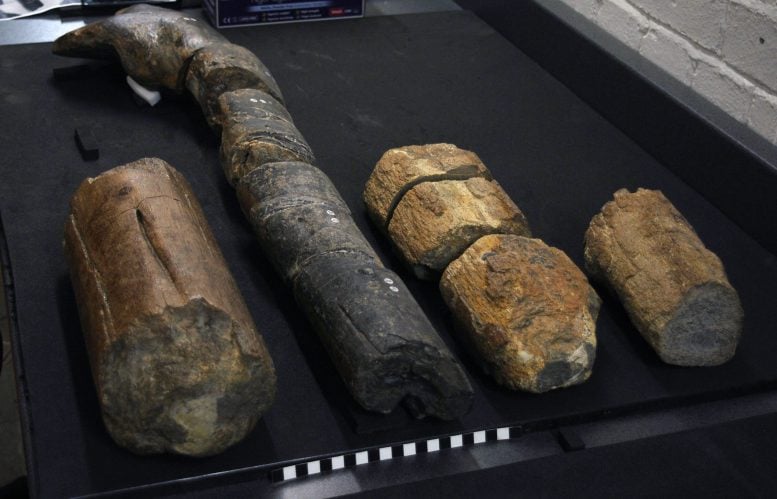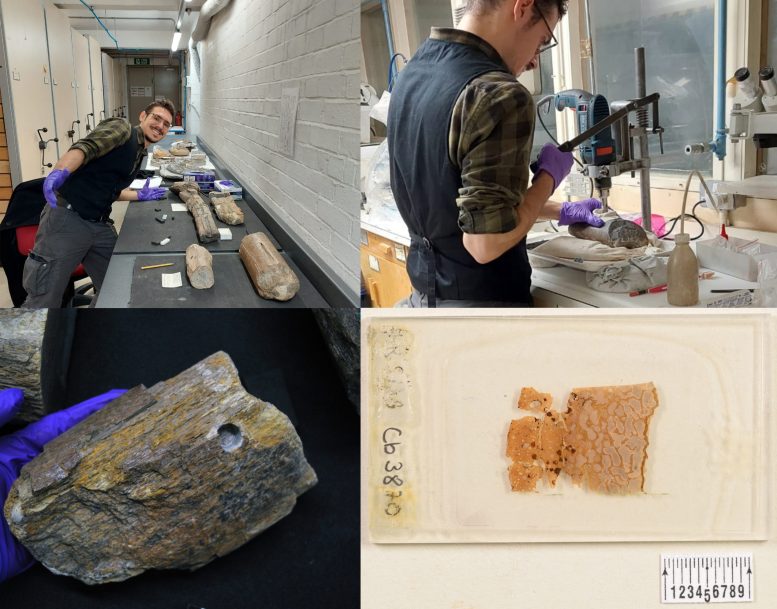A reconstruction of a giant ichthyosaur floating dead on the ocean’s surface. Ichthyosaur remains have been found in marine sediment at various locations in Europe. Photo credit: Marcello Perillo / University of Bonn
Since the 19th century, several similarly sized fossilized bone fragments have been discovered in various regions of Western and Central Europe. The group of animals to which they belonged is still the subject of much debate today. A study carried out at the University of Bonn has now finally clarified this dispute: the microstructure of the fossils suggests that they come from the lower jaw of a giant ichthyosaur. These animals could reach 25 to 30 meters in length, a similar size to the modern blue whale. The results have now been published in the specialist journal Peer J.
In 1850, the British naturalist Samuel Stutchbury reported in a scientific journal about a mysterious find: a large, cylindrical bone fragment had been discovered at Aust Cliff – a fossil deposit near Bristol. Similar bone fragments have now been found in various locations in Europe, including Bonenburg in North Rhine-Westphalia and Provence in France. More than 200 million years ago, these areas were submerged by a vast ocean that covered large parts of western and central Europe. Fossil remains of the fauna of the time – including marine and coastal creatures – have been preserved in the sediment.
There is still some debate today about the group of animals to which these large, fossilized bones belonged. When examining the first finds, Stutchbury assumed that they came from a Labyrinthodontia, an extinct crocodile-like land creature. However, this hypothesis was questioned by other researchers, who instead believed that the fossils came from long-necked dinosaurs (sauropods), stegosaurs, or a still completely unknown group of dinosaurs.

For a long time it was unclear which animal these fossilized bones came from. The new study now suggests that they descended from ichthyosaurs. Photo credit: Marcello Perillo/University of Bonn
Unusual fabric made from protein fibers
“Already at the beginning of the 20th century, some other researchers had put forward the theory that the fossils could possibly come from a giant ichthyosaur,” explains Marcello Perillo. The young researcher examined this theory as part of his master’s thesis in Prof. Martin Sander’s working group at the Institute for Geosciences at the University of Bonn. As part of his work, he examined the microstructure of fossilized bone tissue. “Bones similar species generally have a similar structure,” he says. “Osteohistology – the analysis of bone tissue – can therefore draw conclusions about the animal group from which the find comes.”

Using a modified drill, the researchers were able to remove pieces of bone without destroying the valuable fossils. The resulting thin bone cross-sections enable the microstructure to be examined. Photo credit: Deborah Hutchinson/Bristol Museum and Art Gallery
Perillo first took samples of the previously unclassified bones. “I compared specimens from southwest England, France and Bonenburg,” he says. “They all showed a very specific combination of characteristics. This discovery suggested that they could come from the same group of animals.” Using a special microscope, he was then able to show that the bone wall had a very unusual structure: it contained long strands of mineralized collagen, a protein fiber, which were woven together in a characteristic way were that had not yet been found in other bones.
Ichthyosaur bones with a similar structure
Interestingly, fossils of large ichthyosaurs from Canada also show a very similar bone wall structure. “However, this structure is not found in fossil samples from other animal groups that I have studied,” emphasizes Perillo. “Therefore, it is very likely that the fragments in question also belong to an ichthyosaur and that the findings refute the claim that the bones come from a land-dwelling dinosaur.”
It is likely that the fossils came from the lower jaw of a sea creature. By comparing the size of the fragments with the jaws of other species of this group of animals, it is possible to infer the length of the animals: they could possibly have reached a length of 25 to 30 meters, as originally the representatives of the ichthyosaur theory speculated in a previous study. “However, this number is only an estimate and is far from certain – until we find more complete fossil remains,” says Perillo. Still, they were certainly exceptionally large.
The first ichthyosaur lived in the early oceans Triassic Period around 250 million years ago. Species as large as whales existed early on, but the largest creatures only appeared around 215 million years ago. Almost all ichthyosaur species died out at the end of the Triassic, more than 200 million years ago.
The unusual structure of their bone walls – which resembles carbon fiber reinforced materials – likely kept the bone very stable while allowing rapid growth. “These huge jaws would have been exposed to strong shearing forces even if the animal had eaten normally,” says Perillo. “These animals may also have used their snouts to ram their prey, similar to today’s orcas. However, this is currently pure speculation.”
Reference: “The dinosaurs that weren’t: Osteohistology supports giant ichthyosaur affinity of enigmatic large bone segments from the European Raetian” by Marcello Perillo and P. Martin Sander, April 9, 2024, Peer J.
DOI: 10.7717/peerj.17060
Marcello Perillo was supported by the German Academic Exchange Service (DAAD). The excavations carried out by the Institute of Geosciences in Bonenburg were funded by the Office for Archaeological Conservation NRW through the LWL Museum of Natural History.
